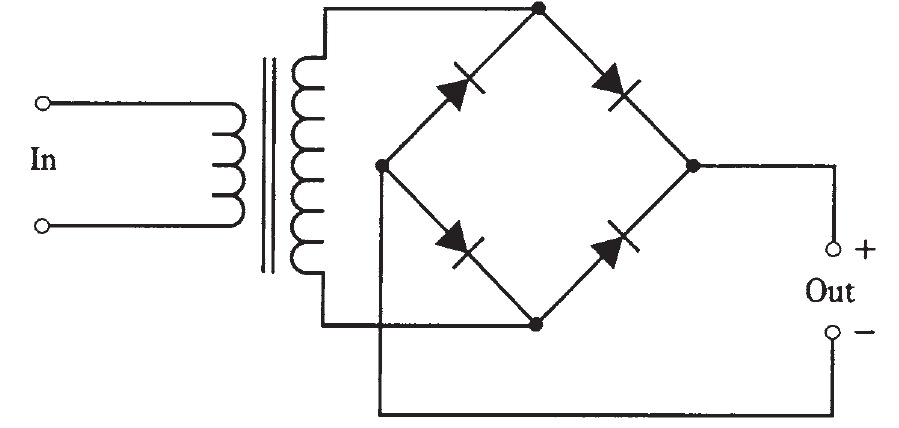


 الفيزياء الكلاسيكية
الفيزياء الكلاسيكية
 الكهربائية والمغناطيسية
الكهربائية والمغناطيسية
 علم البصريات
علم البصريات
 الفيزياء الحديثة
الفيزياء الحديثة
 النظرية النسبية
النظرية النسبية
 الفيزياء النووية
الفيزياء النووية
 فيزياء الحالة الصلبة
فيزياء الحالة الصلبة
 الليزر
الليزر
 علم الفلك
علم الفلك
 المجموعة الشمسية
المجموعة الشمسية
 الطاقة البديلة
الطاقة البديلة
 الفيزياء والعلوم الأخرى
الفيزياء والعلوم الأخرى
 مواضيع عامة في الفيزياء
مواضيع عامة في الفيزياء|
Read More
Date: 17-4-2021
Date: 4-5-2021
Date: 5-5-2021
|
The bridge rectifier
Another way to get full-wave rectification is the bridge rectifier. It is diagrammed in Fig. 1. The output waveform is just like that of the full-wave, center-tap circuit. The average dc output voltage in the bridge circuit is 90 percent of the rms ac input voltage, just as is the case with center-tap rectification. The PIV across the diodes is 1.4 times the rms ac input voltage. Therefore, each diode needs to have a PIV rating of at least 2.1 times the rms ac input voltage.

Fig. 1: Schematic diagram of a full-wave bridge rectifier.
The bridge circuit does not need a center-tapped transformer secondary. This is its main practical advantage. Electrically, the bridge circuit uses the entire secondary on both halves of the wave cycle; the center-tap circuit uses one side of the secondary for one half of the cycle, and the other side for the other half of the cycle. For this reason, the bridge circuit makes more efficient use of the transformer.
The main disadvantage of the bridge circuit is that it needs four diodes rather than two. This doesn’t always amount to much in terms of cost, but it can be important when a power supply must deliver a high current. Then, the extra diodes—two for each half of the cycle, rather than one—dissipate more overall heat energy. When current is used up as heat, it can’t go to the load. Therefore, center-tap circuits are preferable in high-current applications.



|
|
|
|
التوتر والسرطان.. علماء يحذرون من "صلة خطيرة"
|
|
|
|
|
|
|
مرآة السيارة: مدى دقة عكسها للصورة الصحيحة
|
|
|
|
|
|
|
ضمن مؤتمر ذاكرة الألم في العراق مدير كرسي اليونسكو في جامعة الموصل يقدّم دراسةً تناقش استراتيجية الكرسي لنبذ التطرف وتعزيز ثقافة السلام
|
|
|